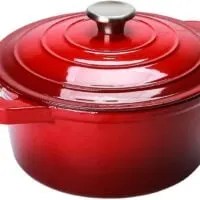By Author Marie-Noël Ouimet
Posted on - Last updated:
Discover our beef and vegetable stew recipe, a traditional Quebec recipe also known as “bouilli de légumes” or “pot-au-feu”.
It’s a comforting dish that celebrates the abundance of the vegetable harvest. Here’s how to prepare this classic recipe from Quebec cuisine, with the know-how passed down by our grandmothers and mothers.

Traditional beef and vegetable stew (pot-au-feu)
Prep Time: 30 minutes
Cook Time: 4 hours
Total Time: 4 hours 30 minutes
The traditional beef and vegetable stew recipe also known as pot-au-feu or French stew
Ingredients
- 4 or 5 pound pieces of beef (bone-in blade roast, chuck or shank) *
- A little olive oil to sear the meat
- 1 pound streaky salted lard
- 1 cabbage, cut in pieces
- The white of a leek, cut in pieces lengthwise
- 1 turnip, cut into large pieces
- 5 potatoes
- Green beans (tied into small bundles with butcher's twine)
- 2 large onions
- A bay leaf
- A sprig of thyme
- 2 - 3 Tbsp beef broth concentrate (ex Bovril)
- Salt pepper
Instructions
- In a large casserole, heat a little olive oil.
- Season the beef cuts with salt and pepper.
- When the oil is hot, sear the pieces of meat (except the lard) on both sides.
- When the meat is nicely colored, set aside.
- Turn down the heat. Pour a little water in the casserole and scrape with a wooden utensil to remove the juices.
- Put back the pieces of meat, the salted lard and cover with water.
- Add 2 Tbsp of beef stock concentrate to the pot.
- Bring to a boil, turn down the heat and simmer for 2 hours (see this section for a lighter broth). During this time, skim the broth a few times.
- Add the vegetables, thyme and bay leaf. Add salt and pepper. Cover and simmer for another 2 hours. After one hour, adjust the seasoning and add the remaining tablespoon of beef stock concentrate if needed.
Notes
Meat: Choose a variety of beef cuts, some fatty and some gelatinous. A piece with a marrow bone will also add a lot of taste to the broth.
Serve with marinated beets and a loaf of bread to dip in the broth.
Tips for making this beef and vegetable pot-au-feu recipe a success

- Tips for making this beef and vegetable pot-au-feu recipe a success
- Choosing the Right Cuts of Meat
- Variety of Vegetables for a Colorful and Nutritious Vegetable Stew
- To obtain a lighter broth
- Suggested Accompaniments
- Recommended Equipment to Make This Recipe
Choosing the Right Cuts of Meat

For your beef stew to have that characteristic rich and deep flavor, opt for various gelatinous beef cuts such as:
- A beef chuck roast, even better with a bone;
- The chuck shoulder, ideal for its tenderness;
- A beef shank to enrich the broth with deep flavors.
Here are a few examples of the cuts of beef I like to use to make boiled beef:
- a bone-in chuck roast;
- beef chuck;
- a beef shank.
And to complete, salted pork is essential for achieving that authentic taste that makes our beef stew recipe famous.
Variety of Vegetables for a Colorful and Nutritious Vegetable Stew

A wide variety of vegetables can be added to pot-au-feu; here are the ones most often found in the classic recipe:
- Leeks and turnips for their subtle flavors.
- Carrots and potatoes for texture and creaminess.
- Green or yellow beans, green cabbage, celery, and onions for a touch of crunch and freshness.
These vegetables are carefully selected to create a perfect balance between flavors and nutritional benefits, making this vegetable stew a healthy choice for the whole family.
Recommended for you
- Braised beef recipe with red wine and onions
- Beer and maple braised ham recipe
- Braised and Pulled Turkey Pasta
To obtain a lighter broth

For those who would like a less fatty broth, it is possible to prepare it in advance. This way, you can degrease it before continuing with the cooking of the stew.
To do this, follow the first steps of the recipe: brown the meat, add water and salted pork, then let it simmer.
At the end of cooking, refrigerate the meat and broth separately.
The next day, or after several hours, the fat will have solidified on the surface of the broth. You can then remove it, reheat the broth, and continue by adding the vegetables and meat.
Suggested Accompaniments
Serve your stew with marinated beets and a good fresh bread.
The vinegary and salty pickles will complement the robust flavors of the beef and vegetable stew.
Recommended Equipment to Make This Recipe
Continue reading
Tortellini and vegetable soup “in brodo” style
Read more
Easy pasta recipe (orecchiette) with Italian sausage and rapinis
Read more
Grilled chicken breast marinade recipe
Read more
Asian salad with lobster (or seafood)
Read more
Easy and Economical Chinese Macaroni Recipe with Ground Pork and Broccoli (Macaroni chinois)
Read more
Beer and maple braised ham recipe
Read more
* This website makes use of sponsored and/or affiliate links. I am a participant in the Amazon Services LLC Associates Program. As an Amazon Associate I earn from qualifying purchases by linking to Amazon.com and affiliated sites. It means that a small commission may be paid if a purchase is made through these links at no extra cost to you. It help us to cover the costs of maintaining this website and to offer you content free of charge.


